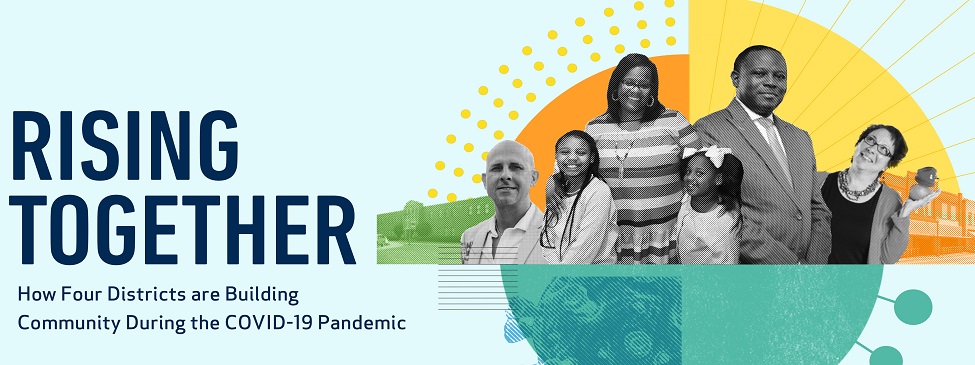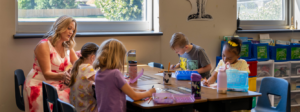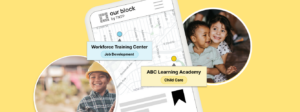The story below is an excerpt from our recent report, Rising Together: How Four Districts are Building Community During the COVID-19 Pandemic. If you're interested in learning how to build community in your district, we are offering a free series of workshops starting February 18. You’ll learn about TNTP’s approach to community engagement, gain actionable insights, and complete guided activities to support you in engaging families more intentionally in your community. You can sign up here.
Additionally, we want to congratulate Hamilton County Superintendent Dr. Bryan Johnson, who is featured below, for being named a finalist for AASA Superintendent of the Year. We are so honored to have had the opportunity to work with him and his team.
Just before midnight on April 12, 2020 – roughly a month after Hamilton County Schools (HCS) halted in-person instruction due to the spread of COVID-19 – a tornado with winds up to 145 miles per hour touched down in Chattanooga, the county seat and fourth largest city in Tennessee., From there, the tornado traveled a nine-mile, 1500-yard-wide path through the area, leaving thousands without electricity, hundreds of homes and buildings damaged or destroyed, dozens of people hospitalized, and at least 10 residents lost. HCS was a key player in the community’s response to the tornado. “As far as this tragedy, we are thinking about our families and our students and employees and the community at large and are really trying to ensure that they are taken care of and their needs are met,” the district’s superintendent Bryan Johnson said when asked about the efforts and impact of the area’s schools during the crisis. Perhaps the best way to understand HCS’s response is to examine the billboards they put up across the district. From the urban center of Chattanooga to the outer edges of Hamilton County, these billboards had a simple but critical message: the phone number to a regularly staffed resource hotline facilitated by the district, designed to ensure that every parent could readily access information and resources such as counseling, supplies, and academic support.
HCS’ well-coordinated and community-centered response to the tornado did not happen by accident. Long before this tragedy took place, HCS was deeply invested in authentic community engagement. In April 2019, HCS formalized partnerships with local government agencies and community organizations to launch the first-ever Children’s Cabinet. Designed to help ensure every student in Hamilton County has access to the resources they need to thrive, the Cabinet initially supported the district’s pilot of Student Success Plans to meet the needs of the whole child—and it continues today. HCS made it a priority to establish initiatives such as the Children’s Cabinet and partnerships with Chattanooga 2.0 and United Way because of its commitment to proactively forging collaborative relationships with community leaders and groups.
Proof of this can be found in the make-up of the district’s School Reopening Task Force. By the end of the 2019-20 school year, the district brought together a multifaceted collection of non-profits, businesses, after-school centers, healthcare providers, school leaders, teachers, and parents. Their primary focus was to ensure that when schools reopened in the fall, there were not only clear guidelines in place keep the district’s students and staff as safe as possible, but also a plan to mitigate the impact of these new policies on procedures on student learning and the well-being of the HCS community. To summarize the Task Force’s purpose, Superintendent Johnson said in a release from the district’s newsroom that “The Task Force will take what we have learned as our teachers and students have responded remarkably during this COVID-19 pandemic and reimagine every aspect of what we do to be an even better school district when we are able to provide a safe return to classrooms across Hamilton County.”
Superintendent Johnson couldn’t have been more right about what was to come. By the end of the summer, the district, alongside United Way and Chattanooga 2.0 (a coalition of roughly 100 groups committed to transforming education in Chattanooga-Hamilton County by focusing on equity and workforce development) established 21 full-time and 16 hybrid Virtual Learning Centers with a goal of providing a safe, supportive environment for students to gather in small groups, with the guidance of trained adults, to engage in the district’s remote learning program. These centers, spread throughout Hamilton County and hosted by a variety of community partners, from YMCAs to churches to museums to even the Chattanooga Zoo, ensure that no student in the district has to be left alone because of a parent’s work schedule, while also bridging gaps in internet connectivity, food access, and specialized academic supports that have widened due to the COVID-19 pandemic and the coinciding economic recession.
Hoping to maximize opportunities for community partners to engage in this initiative and recognizing that the needs of students and families would evolve due to the pandemic, the Virtual Learning Centers were designed to be different. As the district’s request for partners describes, “This is an opportunity for local organizations to fulfill a need in the community and to support the families they serve. There are multiple levels of engagement, everyone can participate in some way.” In practice, this means that certain Virtual Learning Centers offer services five days a week to help students navigate the district’s at-home learning curriculum. For those community partners who wanted to help but weren’t equipped to provide this level of support, there were other meaningful opportunities. HCS, The United Way, and Chattanooga 2.0 had the foresight to recognize that additional capacity would be necessary if the district needed to shift to hybrid learning – a mixture of in-person and remote learning. As such, they invited community partners to provide “Phase II” support, helping to facilitate student learning two to three days a week if the district needed to pivot to hybrid learning. In early December, when HCS announced that it was temporarily making this shift due to rising COVID-19 cases, these community partners were quickly activated to bolster the county’s resources for students and their families. The process of engaging “Phase II” partners to immediately begin providing services went smoothly because the groundwork and preparation began in early August.
Community partners were also invited to coordinate and facilitate education wellness checks across Hamilton County. The purpose of the education wellness checks is to connect a Community Success Coach with an HCS student to support their continued focus on academic growth amidst the pandemic. Families were invited to opt into this support service, recognizing that many parents are working and thus unable to regularly monitor their child’s academic progress on the district’s remote learning curriculum – “HCS at Home.” Community Success Coaches from across the county were paired with students to help them identify and overcome learning barriers, particularly student attendance and submission of high-quality work.
And, finally, it should be noted that the Centers themselves were not all “ready-made” education assets. Instead, the district modeled inclusivity by giving faith-based partners with a desire to operate Virtual Learning Centers the opportunity to apply for microgrants from the Hamilton County Schools Foundation, made possible through a partnership with the Generosity Trust, to cover program costs such as transportation, utilities, technology, face masks, and staffing. This approach allowed for the Virtual Learning Centers to be far more diverse and geographically dispersed than would have been otherwise, and also provided a way for the region’s robust faith-based community to directly partner with HCS schools by adapting their physical spaces and purchasing essential supplies needed to fulfill student and staff needs.
Back in May, Superintendent Johnson told the Chattanooga Times Free Press that “What [the pandemic] has done is forced systems to think differently about how we deliver education. Candidly, I think many systems will be transformed forever, and we will be one of those.” It’s probably too soon to say exactly which of Hamilton County School’s innovations will remain once the region regains its footing after the COVID-19 pandemic, but even at this point in time it feels fair to say that the district and its countless partners have not only surfaced a new proof point about what can happen when communities come together, but also reinvented and redefined the role and importance of Hamilton County Schools.








